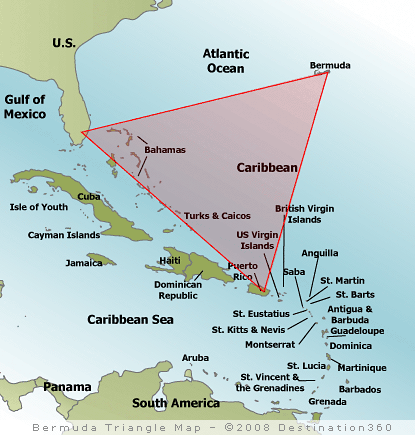Perhaps it is mankind's nature to form a fascination with things that seem to defy logic or scientific explanation. From ghost tales to UFO abductions to Bigfoot, most of us are tantalized by terrific and terrifying tales. The Bermuda Triangle is no exception.
Although many people dispute the size of the geographical area known as the Bermuda Triangle, the general consensus is that the boundaries of this mystical area extend to San Juan, Puerto Rico, the southernmost tip of Florida, and the Caribbean island of Bermuda. This results in thousands of square miles of the Atlantic Ocean, a geographical area larger than several American states combined.
This vast expanse of sea is allegedly responsible for thousands of plane crashes and shipwrecks. But is this "Devil's Triangle" really a mysterious place? Basic logic says no.
The area known as the Bermuda Triangle contains some of the most traveled shipping routes in the world. The area is also in a geographical region where hurricanes and tropical storms are common occurrences. When we stop to consider these factors, it is only logical that this particular area is prone to higher-than-average accident rates.
Using the same criteria, a line can be drawn connecting any three major American cities with heavily-traveled highways. We can easily connect, for example, the cities of Washington DC, Baltimore, and Philadelphia in order to form a triangle. Even though this geographical region is several times smaller than the Bermuda Triangle, so many major highways and flight paths are contained within the triangle that the annual casualties and fatalities occurring within its boundaries far exceed the number of fatalities occurring within the Bermuda Triangle. But does anyone ever speak of the "mysterious" Baltimore-DC-Philadelphia Triangle? No, because there is a logical, legitimate explanation.
There are also legitimate explanations behind the disappearances and accidents surrounding the Bermuda Triangle. The most famous incident occurred in 1945, when a squadron of American bombers mysteriously disappeared over the Bermuda Triangle on a routine training mission. While believers of the Bermuda Triangle point to this famous incident, they do not point to several known facts. On the day of the disappearance, bad weather was reported in the area. The leader of the squadron, Lt. Charles Taylor, was the only member of the squadron who was an experienced aviator. Unfortunately for the other pilots in the squadron, Lt. Charles Taylor was also prone to getting lost. Taylor became lost three times throughout World War II, and twice he had to ditch his plane. This is a fact which never seems to get mentioned much when talking about the "mysterious disappearance of Flight 19".
While all legends are rooted in some small measure of fact, legends grow over time the more they are told. This is why the Bermuda Triangle continues to fascinate us to this day. However, by looking at the Bermuda Triangle and the circumstances of the disappearing ships, yachts, and planes logically, it is no more mystical, deadly, or sinister than any other geographical part of the world.
